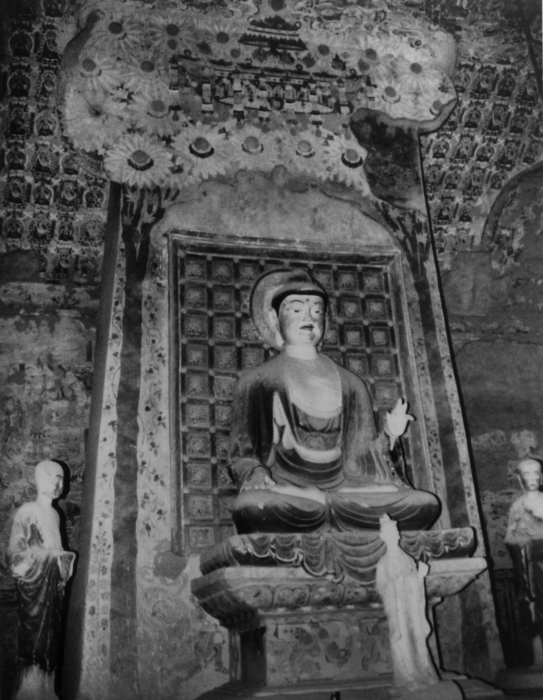


敦煌(人口 10 万人)はゴビ砂漠の南西端にあり、中国北西部の甘粛省の北京から西に約 1,100 マイルのところにあります(北緯 40.05 度、東経 94.45 度)。敦煌の近くには莫高窟(標高約 5,000 フィート、年間降水量 25 mm)があります。気候は温帯大陸性で、夏は暖かく乾燥し、冬は寒いです。気温は 7 月の平均で 26 度、1 月は -7 度です。風と砂嵐は年間を通じて発生します。莫高窟は自然の崖面に掘られており、高さ 80 ~ 100 フィート、ほぼ南北に走っており、柔らかく、固結の少ない細粒の礫岩から砂岩に変化しています。
合計 492 の洞窟が 1 マイルの崖面に沿って 5 層に分かれて位置し、紀元後 4 世紀以降に造られたものです。これらの洞窟は仏教の壁画や彩色彫刻の宝庫となっています。この遺跡は国連教育科学文化機関の世界遺産リストに登録されており、その重要性は中央アジアと中国を結ぶシルクロード上の敦煌の位置からも生まれています。そのため、この遺跡は歴史的、宗教的、芸術的に非常に重要なものです。深刻な自然浸食や破壊行為にも関わらず、約 45,000 平方メートルのフレスコ画と 2,000 体を超える彩色彫刻 (最大のものは高さ 33 メートル) が残っています。
莫高窟の観光は急速に成長しており、地元の管理組織である敦煌研究院に、より多くの洞窟を開放するよう圧力をかけている。効果的な保存政策を策定するには、観光の影響、特に湿度と微生物による劣化の影響に関するデータが必要だった。時には有害な観光客の往来を減らす努力の一環として、このプロジェクトは最終的に、最も人気のある洞窟 10 か所のレプリカの建設につながった。
環境モニタリング プログラムは、ゲッティ保存研究所 (GCI) による遺跡保全活動の 1 つとして提案されたもので、訪問者が壁画や彫刻の劣化に与える影響を特定することを目的としています。6 つの洞窟で、相対湿度、気温、表面温度、二酸化炭素、屋内外の粒子状物質、訪問者数、訪問期間が集中的にモニタリングされました。
1995年に完成したこのプロジェクトは、洞窟の環境モニタリングステーションが設置された1990年9月に正式に開始されました。1989年10月のプロジェクト前現地調査中に、基礎データを収集するために、現場を見下ろす崖の上に気象ステーションが設置されました。ベースステーションは、敦煌科学院の研究棟に設置されました。
気象観測所は、Campbell Scientific CR10 測定および制御モジュール、CM6 三脚、筐体、ソーラー パネル、気候センサーで構成され、データの取得は UHF テレメトリ (P50 無線、RF95 RF モデム、バッテリー駆動の RF ベース ステーション) によって行われます。東芝 T1600 ラップトップがバッテリー駆動のベース ステーション コンピューターとして機能しました。
このエリアのコンピューターの保守に関連する問題のため、二次的なデータ取得メカニズムが必要であると判断されました。数か月分のバックアップ データ ストレージを提供するために、SM716 ストレージ モジュールがサイトに追加されました。
メニュー方式のユーティリティ ソフトウェアがフロントエンド インターフェイス プログラムとして提供されたため、訓練を受けていないオペレータでも、数回のキー操作でシステムを監視し、データをアップロードできます。また、データは毎週、敦煌科学院の技術スタッフによってディスケットにアップロードされ、航空便で GCI に送られました。